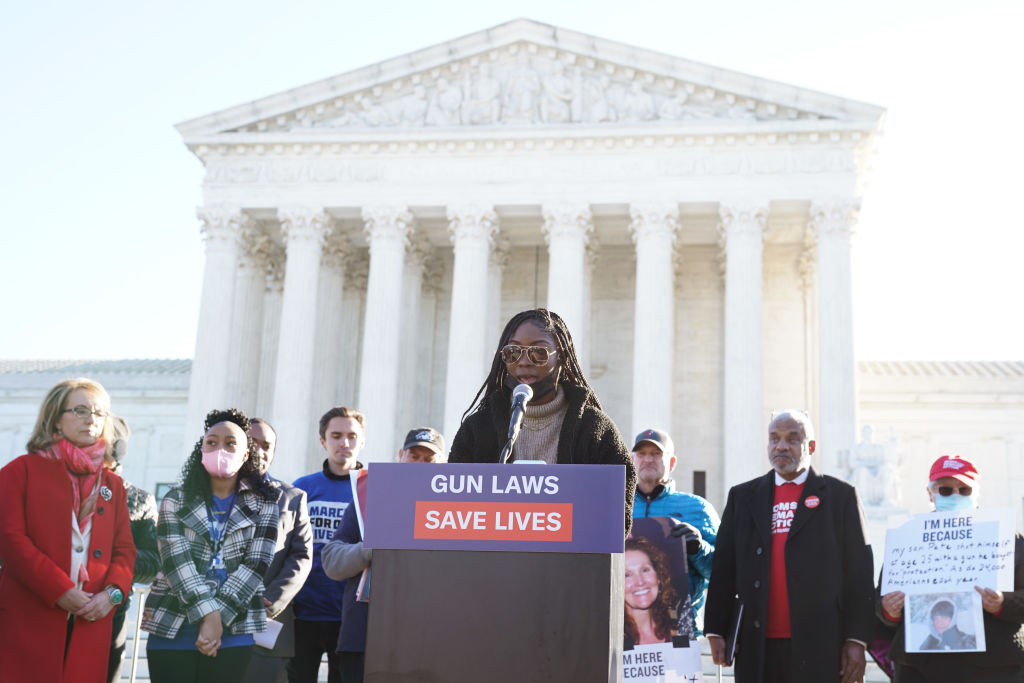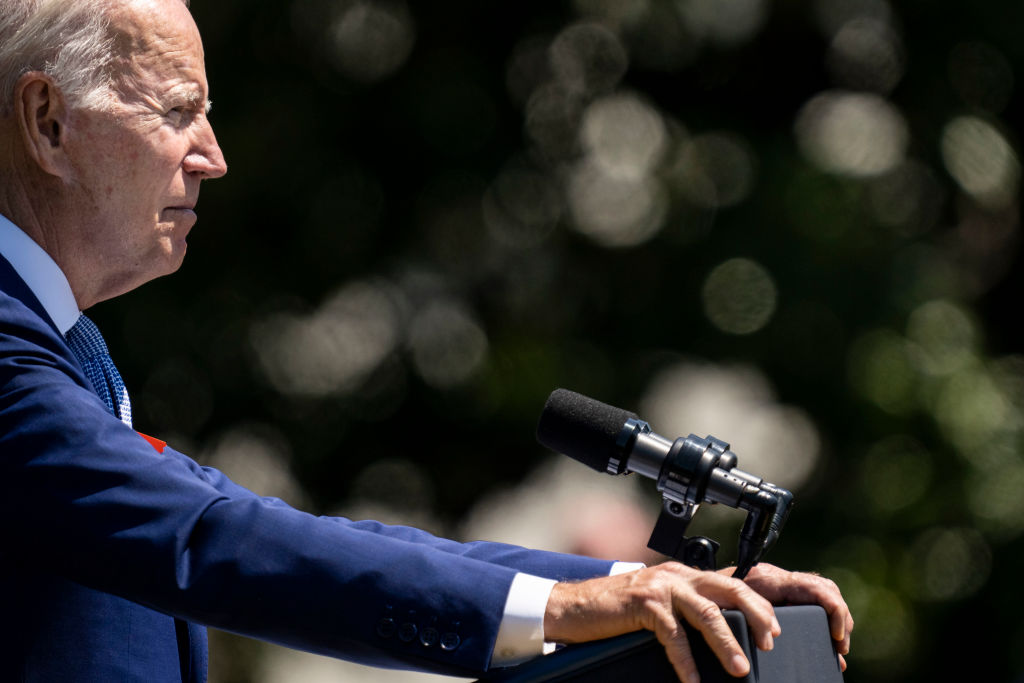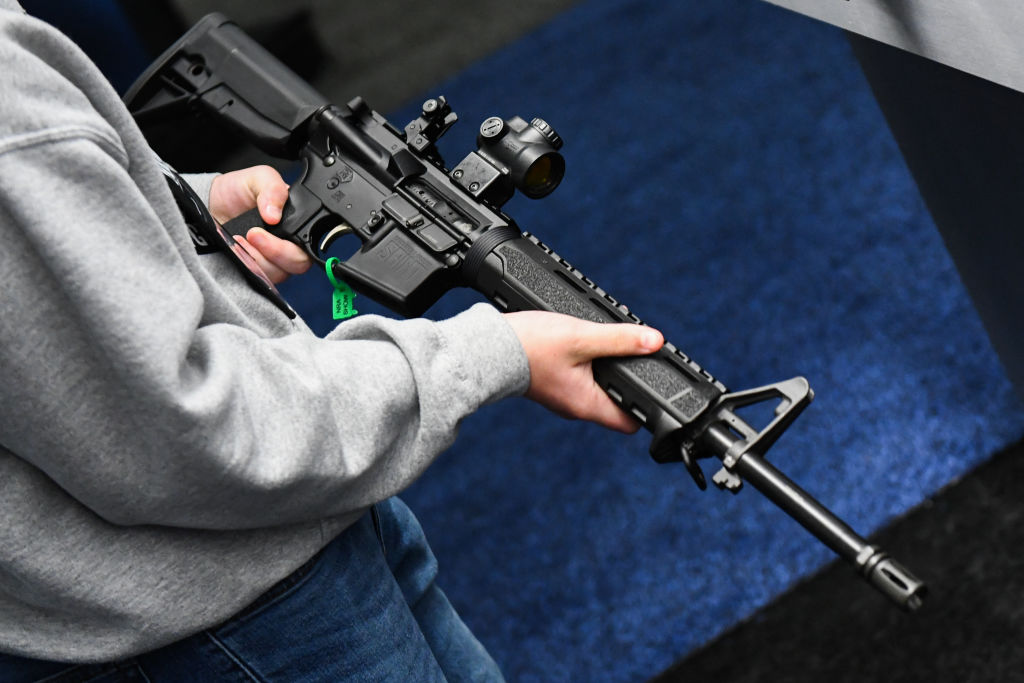

As the second half of 2022 began to unfold, gun violence and gun control once again moved center stage, along with abortion, in American politics.
A series of particularly devastating shooting massacres took place during the summer, including an attack on Robb Elementary School in Uvalde, Texas, in which an 18-year-old assailant shot dead 19 school children and two teachers.
The horror of those attacks provoked an outpouring of anger and, in some quarters, a determination to effect policy changes in the notoriously slow-moving arena of gun violence.
In late June, U.S. President Joe Biden signed into law the first piece of gun control legislation passed by the U.S. Congress in decades — a bill that offers financial incentives to states to pass their own "red flag" laws, which allow the court-ordered removal of firearms from individuals deemed to be a threat to others or themselves.
However, the U.S. Supreme Court also overturned New York state's "proper cause" requirement for obtaining a firearms license, in a ruling that could have far-reaching consequences for other gun control laws.
So where does all this leave America's seemingly never-ending gun debate? The following is our breakdown of the policy disputes to look out for in the coming months.

Aalayah Eastmond speaks as gun violence survivors gather in front of the Supreme Court ahead of oral argument in NYSRPA v. Bruen on November 03, 2021 in Washington, D. C. (Photo by Leigh Vogel/Getty Images for Giffords Law Center)
The case revolved around two New York state residents who had unsuccessfully applied for a unrestricted license to own and carry a firearm in public, based on the "proper cause" requirement of state law.
Chapter 40, Part 4, Article 400 of New York's penal laws stipulates that state officials can only give an unrestricted license to applicants who can show that "proper cause exists" for having one. State courts have further stipulated that proper cause requires "a special need for self-protection distinguishable from that of the general community."
In their license applications, the two men explained that their motivation was a generic desire for self-defense. Their applications were rejected, but they appealed until the case reached the highest court in the country — arguing that the "proper cause" requirement in New York state law was unconstitutional in that it violated their 2nd- and 14th-Amendment right to bear arms.
On June 23, 2022, the U.S. Supreme Court voted 6-3 to overturn lower court rulings that supported the rejection of the license applications, and also declared the proper cause requirement unconstitutional.
In a majority opinion, Justice Clarence Thomas wrote:
We know of no other constitutional right that an individual may exercise only after demonstrating to government officers some special need. That is not how the First Amendment works when it comes to unpopular speech or the free exercise of religion. It is not how the Sixth Amendment works when it comes to a defendant’s right to confront the witnesses against him. And it is not how the Second Amendment works when it comes to public carry for self-defense.
Moreover, Thomas' opinion involved a significant shift in jurisprudence on gun control, as opposed to earlier rulings, and one that could have substantive implications for state gun licensing and gun control laws around the country.
Historically, the court had evaluated 2nd Amendment restrictions — i.e., gun control laws — by assessing whether a given restriction is compatible with the text of the 2nd Amendment; supported by or based in history; or is warranted in light of some specific pattern of actual harm to society — as demonstrated, for example, with data about gun violence.
In Bruen, the court explicitly rejected the latter "empirical" type of scrutiny. Rather, the majority ruled, only the historical analysis should be taken into account. As some critics of the ruling have written:
. The implication of the court’s decision is that empirical evidence is never relevant to the constitutionality of gun laws. Under the majority’s view, even if a regulating state could definitively demonstrate that one million lives could be saved by a particular firearm restriction, this would be irrelevant unless there is a “representative historical analogue” to that law.
In a direct and specific sense, the court's ruling in Bruen will likely soon lead to successful court challenges to similar "proper cause" licensing regimes in six other jurisdictions: California; Washington, D. C.; Hawaii; Maryland; Massachusetts; and New Jersey.
More broadly, the explicit rejection of the use of empirical evidence will likely make it harder for states to come up with innovative legal and regulatory ways to restrict access to firearms.

President Joe Biden delivers remarks during an event commemorating the of the passage of the Bipartisan Safer Communities Act on the South Lawn of the White House on Monday, July 11, 2022 in Washington, D. C. (Kent Nishimura / Los Angeles Times via Getty Images)
In one sense, the most important thing about S. 2938 — the Bipartisan Safer Communities Act — was the mere fact that it made it through both houses of Congress, to be signed into law by Biden on June 25.
In recent decades, political polarization has prevented congressional efforts to introduce greater restrictions on gun access and ownership, despite fairly consistent public support for such efforts, and in the face of several shocking shooting massacres.
So the passage of the bill — which the pro-gun control Giffords Center called "the first significant gun safety legislation to become law in nearly 30 years" — was a significant political development in and of itself.
Moreover, it passed the Senate with substantial Republican support — 15 GOP senators crossed the aisle to vote in favor of it — suggesting a potential base of moderate Republican support for future gun control measures.
Compared with the significance of its passage, the law is arguably more modest in its likely practical consequences. In terms of gun control policy, its two most substantive provisions are as follows:
The red flag funding may soon begin to circulate among eligible states — 19 states and Washington, D. C. currently have such laws — and younger would-be gun owners might soon begin to feel the effects of enhanced background check restrictions and delays.
However, the biggest significance of the Bipartisan Safer Communities Act might ultimately be in its heralding of the possible formation of a post-Uvalde cohort of GOP senators willing to join with Democrats in passing gun control legislation, and as an opening gambit in efforts to combat, specifically, gun violence among young men.

An attendee holds a Springfield Armory SAINT AR-15 style rifle displayed during the National Rifle Association (NRA) Annual Meeting at the George R. Brown Convention Center, in Houston, Texas, on May 28, 2022. (Photo by PATRICK T. FALLON/AFP via Getty Images)
During the summer of 2022, several of the most brutal and destructive mass shootings were allegedly perpetrated by young men who were aged under 21 either when they carried out their attack, or when they acquired the semi-automatic rifle they used.
Payton Gendron, for example, was 18 years old in May 2022 when, according to prosecutors, he shot dead 10 Black people in a racially motivated massacre at a Buffalo, New York, supermarket.
Salvador Ramos purchased a semi-automatic rifle and ammunition as soon as possible after his 18th birthday, in May 2022, just days before he slaughtered 19 school children and two teachers at Robb Elementary School in Uvalde, Texas.
More broadly, men aged under 21 have, in recent years, committed an unusually high proportion of mass shootings, and legal age limits on gun possession have been linked to suicide rates among young men.
As such, one major policy change that could come about as a result of the events of the summer of 2022 is an increase in the legal age limit for purchasing various kinds of firearms, from 18 to 21.
In fact, Congress has already seen exactly such proposals this summer. First, as part of negotiations over the Bipartisan Safer Communities Act, although the final legislation ultimately left out a measure that would have changed the federal age limit for purchasing a semi-automatic rifle from 18 to 21 years.
Separately, in June the U.S. House narrowly passed the Protecting Our Kids Act, which contains several provisions including that new federal age limit of 21 for purchasing a semi-automatic rifle.
The bill is not expected to make it through the Senate, especially given the fact that that a similar measure was nixed during a separate set of negotiations earlier in the summer.
However, public support for raising the national age limit on gun purchases is remarkably strong (nearly three quarters overall, including 59% of Republicans, are in favor of it). That underlying level of public support, combined with a possible partisan reconfiguration in Congress after the November mid-terms, could well see the gun purchase age limit return to the agenda in Washington in 2023.
Separately, various state legislatures might also turn their attentions to increasing that age limit, as New York lawmakers did in June, in the aftermath of the Uvalde massacre.
As of mid-2022, more than half of the states in the nation had a minimum legal age for buying or owning firearms that was below 21 years old. Given the breadth and depth of revulsion about shooting massacres perpetrated by teenagers, it would be reasonable to expect that legal status quo to change in some states, in the coming months.
CNN, Manu Raju, Lauren Fox and Ted Barrett. “Key GOP Senators Signal That Raising Age to Buy Semiautomatic Weapons Is off the Table.” CNN, https://www.cnn.com/2022/06/06/politics/gun-negotiations-congress-republicans/index.html. Accessed 4 Aug. 2022.
“Congress Wants More Red-Flag Laws. But GOP States, Gun Groups Resist.” Washington Post. www.washingtonpost.com, https://www.washingtonpost.com/politics/2022/07/18/red-flag-laws-biden-state-gop/. Accessed 4 Aug. 2022.
Federal Grand Jury Indicts Accused Tops Shooter on Federal Hate Crimes and Firearms Charges in Buffalo, New York. 14 July 2022, https://www.justice.gov/opa/pr/federal-grand-jury-indicts-accused-tops-shooter-federal-hate-crimes-and-firearms-charges.
Franck, Thomas. “House Passes Sweeping Gun Bill to Raise Assault Rifle Purchase Age to 21; Plan Faces Long Odds in the Senate.” CNBC, https://www.cnbc.com/2022/06/08/uvalde-school-shooting-us-house-votes-to-raise-age-to-buy-an-assault-rifle-to-21.html. Accessed 4 Aug. 2022.
“Giffords Celebrates President Biden’s Signing of Bipartisan Safer Communities Act.” Giffords, https://giffords.org/press-release/2022/06/giffords-celebrates-president-bidens-signing-of-bipartisan-safer-communities-act/. Accessed 4 Aug. 2022.
“Gunman Bought Two Rifles, Hundreds of Rounds in Days before Massacre.” Washington Post. www.washingtonpost.com, https://www.washingtonpost.com/nation/2022/05/25/uvalde-texas-school-shooting-gunman/. Accessed 4 Aug. 2022.
Inc, Gallup. “Guns.” Gallup.Com, 18 May 2007, https://news.gallup.com/poll/1645/Guns.aspx. “Legislation.” NY State Senate, https://www.nysenate.gov/legislation/laws/PEN/400.00. Accessed 4 Aug. 2022.
“Minimum Age to Purchase.” Everytown Research & Policy, https://everytownresearch.org/rankings/law/minimum-age-to-purchase/. Accessed 4 Aug. 2022.
Nearly 3 Out Of 4 Support Raising Legal Age To Buy Any Gun, Quinnipiac University National Poll Finds; Support For Assault Weapons Ban Hits A Low | Quinnipiac University Poll. https://poll.qu.edu/poll-release?releaseid=3848. Accessed 4 Aug. 2022.
“New York Governor Signs Law Raising Age to Own Semiautomatic Rifle.” CNBC, https://www.cnbc.com/2022/06/06/new-york-governor-signs-law-raising-age-to-own-semiautomatic-rifle.html. Accessed 4 Aug. 2022.
Raifman, Julia, et al. “State Handgun Purchase Age Minimums in the US and Adolescent Suicide Rates: Regression Discontinuity and Difference-in-Differences Analyses.” BMJ, vol. 370, July 2020, p. m2436. www.bmj.com, https://doi.org/10.1136/bmj.m2436.
Schaeffer, Katherine. “Key Facts about Americans and Guns.” Pew Research Center, https://www.pewresearch.org/fact-tank/2021/09/13/key-facts-about-americans-and-guns/. Accessed 4 Aug. 2022.
Thrush, Glenn, and Matt Richtel. “A Disturbing New Pattern in Mass Shootings: Young Assailants.” The New York Times, 2 June 2022. NYTimes.com, https://www.nytimes.com/2022/06/02/us/politics/mass-shootings-young-men-guns.html.
U.S. Senate: U.S. Senate Roll Call Votes 117th Congress - 2nd Session. https://www.senate.gov/legislative/LIS/roll_call_votes/vote1172/vote_117_2_00242.htm. Accessed 4 Aug. 2022.
Washington, U. S. Capitol Room H154, and DC 20515-6601 p:225-7000. “Roll Call 245 Roll Call 245, Bill Number: H. R. 7910, 117th Congress, 2nd Session.” Office of the Clerk, U.S. House of Representatives, 8 June 2022, https://clerk.house.gov/Votes/2022245.
Dan Mac Guill is a former writer for Snopes.